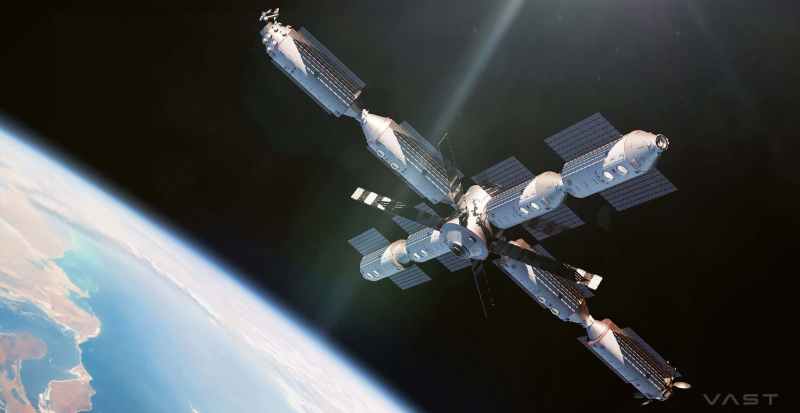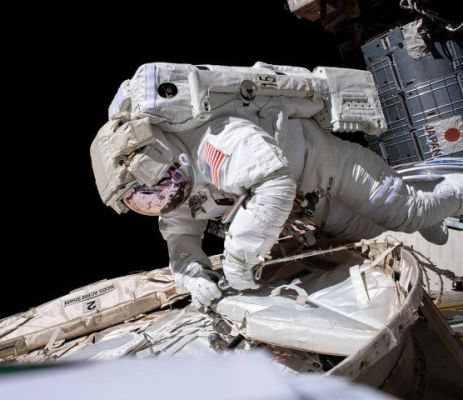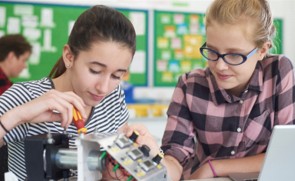
Think about the following questions.
1. What do you know about the International Space Station?
2. Do you think governments should spend more or less money on space exploration? Why?
3. Do you think ordinary people will be able to travel to space within your lifetime?
VOCABULARY PREVIEW
Match each New Academic Word List(NAWL) word with the correct definition.
- chunk _____
- radiation _____
- alien _____
- ray _____
- bullet _____
- accumulation _____
- a. the projectile from a gun
- b. a narrow stream of energy traveling in a straight line from its place of origin
- c. a piece, especially of jagged or random shape
- d. a gradual gathering of something
- e. the emitting of electromagnetic energy, such as light or heat
- f. a life form from another planet
THE ISS AND THE FUTURE OF SPACE

The year 2020 marked a major milestone1 for the International Space Station (ISS): a record twenty years of continuous human presence in space. This is not an accomplishment to take for granted. The station's age is a growing concern and has spurred2 some discussion of the eventual end of the ISS's mission. The US and Russia have tentatively agreed to continue their cooperation in operating the station until at least 2025, but at some point, it will be necessary to retire the ISS. With the end in sight, the station's groundbreaking research is all the more important, as it will lay the foundation for the next stage of humanity's exploration of space.
Since 2011, the ISS has been home to the Alpha Magnetic Spectrometer (AMS), an experimental device that supports research in high-energy theoretical physics. The AMS is a tool that records the presence of cosmic3 rays in its search for such phenomena as antimatter and hypothetical4 dark matter5. So far, it has recorded more than sixty billion manifestations6 of cosmic energy. Nobel Laureate Samuel Ting of the Massachusetts Institute of Technology leads the physicists assigned to interpret the latest findings. Ting believes that thanks to AMS data, his team is on the brink of identifying the origins of dark matter.
Cosmic radiation can also be dangerous to humans in space. A better understanding of this radiation will be needed before astronauts may safely travel to destinations farther out into the universe, like Mars. The ISS is the ideal place for developing the technology to support a mission to Mars, the planning for which is already under way7. One of the greatest challenges facing such missions is the unknown effects of long-term spaceflight on the human body. In 2016, astronaut Scott Kelly of NASA and Russian cosmonaut Mikhail Kornienko returned home safely after 340 days aboard the ISS. Very few humans have spent such a long time in space, so this was an important opportunity for discovery. Then in 2017, Peggy Whitson set a new record for NASA astronauts with an amazing 665 straight days in space. Kelly and Whitson are being closely monitored for changes to their eyesight, hearing, metabolism, and even gene expression. Their time on the station will provide ample8 opportunities to refine the skills that will be needed by the astronauts who someday venture beyond Earth's orbit.
In addition to helping explore the universe beyond our planet, the ISS also has important work to do closer to home. Some scientists have proposed equipping the station with a powerful laser-not for blasting asteroids9 or hostile aliens, but for removing space trash. An accumulation of as much as 3,000 tons of junk is already in Earth's orbit, some traveling at speeds over 20,000 miles per hour, over ten times faster than the average bullet. As accurately dramatized in the 2013 movie Gravity, collisions with even tiny chunks of space trash pose a serious danger to satellites, the ISS itself, and other spacecraft. Telescopes on the station could detect tiny pieces of debris10 in orbit and target a laser to deflect11 the course of the junk down into the atmosphere, where it would burn up. Japanese researchers plan to test such a system on the ISS. "We may finally have a way to stop the headache of rapidly growing space debris that endangers space activities," project leader Toshikazu Ebisuzaki said.
Though the exploration of space will surely continue, whether in low Earth orbit or beyond, the next step for space stations is hard to predict. One question many observers have posed is whether the next generation of space stations will be operated by governments alone or will involve private companies. Elon Musk's SpaceX has already launched rockets to bring supplies to the ISS, and it is designing reusable vehicles for private travel into space. A private space station might serve tourists along with scientists and astronauts, as well as provide funding for continued" research. In any case, for the near future, the ISS will remain an important player in space exploration.
New Academic Word List
- milestone 1 : n. a significant point in development
- spur 2 : v. to cause
- cosmic 3 : adj. of or relating to the universe or outer space
- hypothetical 4 : adj. theoretical; proposed but not proven
- dark matter 5 : n. a type of matter not yet directly observed but hypothesized to explain various gravitational effects
- manifestation 6 : n. a sign that shows something clearly
- under way 7 : adv. in progress
- ample8 : adj. more than enough
- asteroid 9 : n. any of the thousands of rocky bodies that orbit the Sun, especially between the orbits of Mars and Jupiter
- debris 10 : n. broken pieces of objects; trash
- deflect11 : v. to cause something that is moving to change direction
READING COMPREHENSION
A ‣ Mark each statement as true (T) or false (F) according to the reading.
- The ISS reached an important anniversary in 2020.
- True
- False
- The US and Russia have renewed their commitment to the ISS beyond 2025.
- True
- False
- Samuel Ting leads the team of scientists who analyze data from the AMS.
- True
- False
- Scott Kelly and Mikhail Kornienko hold the record for the longest period spent in space.
- True
- False
- The ISS is now equipped with a laser for deflecting space junk.
- True
- False
B ‣ Choose the best answer according to the reading.
- What is the main purpose of the reading?
- a. To provide an overview of the present status of the ISS
- b. To clarify the role scientists outside the US have in the ISS
- c. To explain how NASA plans to solve radiation and space debris problems
- d. To argue that the US and Russia should continue cooperating in space
- Part of the AMS mission is to gather data about _____.
- a. black holes
- b. space debris
- c. the origin of dark matter
- d. the physiological effects of space flight
- In paragraph 3, the word which refers to _____.
- a. the ISS
- b. technology
- c. mission
- d. Mars
- According to paragraph 5, what might private companies do?
- a. Provide money for future research
- b. Help run future space stations
- c. Bring tourists into space
- d. All of the above
C ‣ Look for the answers in the reading and write them on the lines.
- What is the main cause for concern about the ISS?
_____ - Why is the large amount of space trash in Earth's orbit a serious problem?
_____
SUMMARY
Fill in the blanks with the phrases in the box.
- eyesight, hearing, metabolism
- the origins of dark matter
- laser system
- orbiting Earth safer
- records the presence
- spending long periods
| ISS Plans and Missions |
|
AMS
|
|
Spaceflight's Effects on the Body
|
|
Space Debris
|
VOCABULARY PRACTICE
Fill in the blanks with the words in the box. Change the form if necessary.
- accumulation
- alien
- bullet
- chunk
- radiation
- ray
- Markings on a(n) _____ can help investigators identify the weapon that fired it.
- In movies, _____ are often portrayed as frightening creatures that resemble insects or reptiles.
- Meteorites are small _____ of asteroids or comets that made it all the way to the Earth's surface.
- Though some still worry about the health risks of _____ from cell phones, no evidence has been found to prove that it is dangerous.
- A single _____ of light that enters a small hole in a dark room will produce an image of what is directly outside.
- If you do not clean your fish tank regularly, the _____ of waste will make the water poisonous.
SUPPLEMENTAL READING
Design Your Own Space Research

Beyond childhood aspirations to be an astronaut, few people seriously expect to explore space. However, space research is no longer just for astronauts and astrophysicists. New technologies have opened the ISS to ordinary people—even kids.
One such technology is Ardulab. Ardulab is an open-source science platform that offers anyone the chance to design an experiment on Earth and conduct it in space with an innovative hardware unit. Ten square centimeters in size and weighing only about half a kilogram, the unit is a simple computer that can be customized to conduct a variety of experiments. Using Ardulab's free instructions and software, you build it, program it, have it sent to the ISS for a fee, and control it from your home computer.
The ISS is actively encouraging young people to participate in its mission in a similar way. Teams of students are already competing in the Space Station National Design Challenge, a contest in which they design original experiments for the station. Three winning teams will receive funding and training to help build their devices, and then the completed projects will be launched to the station. For thirty days, the students will be able to collect and analyze the data transmitted back to Earth. In Houston, Texas, middle-school students have already designed experiments.
One team devised a way to determine how zero-gravity affects the growth of algae, and another wants to test materials for improved heat shields.
Fill in the blanks with information from the reading.
- Ardulab allows you to program a small computer and send it _____ to conduct your own experiment.
- The Space Station National Design Challenge invites students to design _____ .
- The winners will be able to _____ thirty days' worth of data sent from the ISS.

Leave a comment
Load more